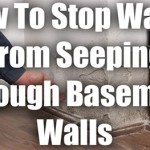Moisture Barrier Paint For Basement Floor And Walls
Basements, often located below ground level, are inherently susceptible to moisture intrusion. This moisture can originate from several sources, including groundwater seepage, condensation due to temperature differences, and humidity. Unmitigated moisture problems in basements can lead to a range of issues, such as mold growth, musty odors, structural damage to building materials like drywall and wood, and an overall decrease in indoor air quality. Addressing basement moisture is, therefore, crucial for maintaining a healthy and structurally sound living environment.
One effective method for combating basement moisture is the application of moisture barrier paint. This specialized coating is designed to create a waterproof or water-resistant barrier on basement walls and floors, preventing moisture from penetrating the treated surfaces. It's important to understand the properties of moisture barrier paint and how it functions to protect against moisture damage.
Moisture barrier paints are typically formulated with ingredients that exhibit hydrophobic properties, meaning they repel water. These ingredients may include acrylic polymers, epoxy resins, and other additives that create a dense, impermeable film upon drying. The specific composition of the paint will vary depending on the manufacturer and intended application, but the overall goal is to create a surface that resists water penetration.
Unlike standard paints, moisture barrier paints are specifically engineered to withstand the damp conditions commonly found in basements. They are often thicker and more durable than ordinary paints, allowing them to better resist the hydrostatic pressure exerted by moisture in the surrounding soil. This resistance to hydrostatic pressure is crucial for preventing moisture from being forced through the coating.
The application of moisture barrier paint involves several steps to ensure optimal performance. Proper surface preparation is paramount. This includes cleaning the walls and floors thoroughly to remove any dirt, dust, loose paint, efflorescence (salt deposits), or other contaminants. Any cracks or imperfections in the concrete should be repaired with a suitable patching compound before painting.
Once the surface is properly prepared, the moisture barrier paint can be applied using a brush, roller, or sprayer. Multiple coats are generally recommended to achieve the desired level of protection. The manufacturer's instructions should be carefully followed regarding the number of coats, drying time between coats, and application thickness. It is also important to ensure adequate ventilation during application and drying.
Selecting the right type of moisture barrier paint is crucial for the specific basement conditions. Factors to consider include the level of moisture present, the type of substrate (concrete, cinder block, etc.), and the desired finish. Some moisture barrier paints are specifically formulated for use on floors, while others are designed for walls. It is important to choose a product that is suitable for the intended application.
Understanding the Benefits of Using Moisture Barrier Paint
The use of moisture barrier paint in basements offers several key advantages. First and foremost, it helps to prevent moisture intrusion, which can lead to a range of problems. By creating a waterproof or water-resistant barrier, the paint helps to keep the basement dry and comfortable.
Secondly, moisture barrier paint can help to prevent mold growth. Mold thrives in damp environments, and basements are often susceptible to mold due to their high humidity and potential for water leaks. By reducing moisture levels, moisture barrier paint can help to inhibit mold growth and improve indoor air quality.
Thirdly, moisture barrier paint can protect building materials from water damage. Excessive moisture can cause wood to rot, drywall to crumble, and concrete to deteriorate. By preventing moisture from reaching these materials, moisture barrier paint can help to extend their lifespan and prevent costly repairs.
Finally, the use of moisture barrier paint can improve the overall comfort and usability of the basement. A dry and comfortable basement is more likely to be used as a living space, storage area, or recreational room. By addressing moisture problems, moisture barrier paint can help to transform a damp and uncomfortable basement into a valuable asset.
Comparing Different Types of Moisture Barrier Paint
Several different types of moisture barrier paint are available on the market, each with its own unique properties and advantages. Some common types include latex-based paints, epoxy-based paints, and cementitious coatings. Understanding the differences between these types of paints is crucial for selecting the right product for a specific application.
Latex-based moisture barrier paints are generally considered to be the most user-friendly and affordable option. They are water-based, easy to apply, and offer good protection against moderate moisture levels. However, they may not be as durable or as effective at resisting hydrostatic pressure as other types of moisture barrier paint.
Epoxy-based moisture barrier paints are known for their exceptional durability and resistance to water penetration. They form a very hard and impermeable coating that can withstand high levels of hydrostatic pressure. Epoxy paints are often used in basements with significant moisture problems or where a high level of protection is required. However, they can be more difficult to apply than latex-based paints and may require specialized equipment or training.
Cementitious coatings are another option for waterproofing basement walls and floors. These coatings are typically made from a mixture of cement, sand, and other additives. They create a very durable and waterproof barrier that is resistant to hydrostatic pressure. Cementitious coatings are often used in basements with severe moisture problems or where a long-lasting solution is required. However, they can be more difficult to apply than other types of moisture barrier paint and may require specialized equipment or skills.
When choosing a moisture barrier paint, it is important to consider the specific conditions in the basement, the type of substrate being painted, and the desired level of protection. Consulting with a paint expert or contractor can help to ensure that the right product is selected for the job.
Essential Steps for Applying Moisture Barrier Paint Effectively
The effectiveness of moisture barrier paint depends not only on the quality of the paint itself but also on the proper application techniques. Following these steps ensures that the paint creates a robust and durable barrier against moisture intrusion.
The first step is thorough surface preparation. This involves removing all loose paint, dirt, dust, and efflorescence from the walls and floors. Wire brushing, scraping, and pressure washing may be necessary to achieve a clean and sound surface. Any cracks or holes in the concrete should be repaired with a concrete patching compound.
Once the surface is clean and repaired, it is important to prime the surface with a suitable primer. The primer helps to improve the adhesion of the moisture barrier paint and ensures a uniform finish. Choose a primer that is compatible with the type of moisture barrier paint being used. Allow the primer to dry completely before applying the paint.
When applying the moisture barrier paint, follow the manufacturer's instructions regarding the number of coats, drying time between coats, and application thickness. Applying the paint too thinly or not allowing sufficient drying time can compromise the effectiveness of the barrier. Use a high-quality brush, roller, or sprayer to achieve a uniform and consistent coating.
Pay particular attention to areas that are prone to moisture intrusion, such as cracks, corners, and joints. Apply extra coats of paint to these areas to ensure that they are adequately protected. Consider using a sealant or caulk along the joints to prevent water from seeping in.
Finally, allow the moisture barrier paint to cure completely before exposing the basement to moisture. The curing time will vary depending on the type of paint and the environmental conditions. Following the manufacturer's recommendations for curing time is essential for ensuring that the paint achieves its full strength and durability.
Following these essential steps can significantly improve the effectiveness of moisture barrier paint and help to create a dry and comfortable basement.
While moisture barrier paint can be a valuable tool in combating basement moisture, it is important to recognize its limitations. In situations with severe water intrusion or high hydrostatic pressure, additional measures may be necessary. These measures may include installing a drainage system, applying a waterproof membrane to the exterior of the foundation, or consulting with a waterproofing specialist.
In conclusion, moisture barrier paint is a practical solution for reducing moisture in basements. Understanding its properties, application techniques, and limitations enables informed decisions regarding its use in creating a drier and more comfortable basement environment.

Kilz Basement Masonry Waterproofer

Basement Vapor Barrier Contractor Iron Mountain Ashland Michigan And Wisconsin

Be Sure To Use A Moisture Barrier When Building Out Your Basement

The Cleanspace Wall Basement Vapor Barrier System

Underslab Retrofits Sealing Slabs Waterproof Magazine

The Cleanspace Wall Basement Vapor Barrier System

Easy Steps To Diy A Vapor Barrier Basement Wall Enthralling Gumption

Basement Solutions For Moisture Control

Is A Vapor Barrier Good Basement Waterproofing Solution

Do Basement Floor Coatings Help With Moisture Solid Custom
Related Posts







